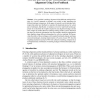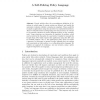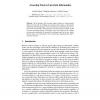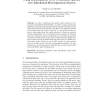SEMWEB
2010
Springer
13 years 9 months ago
2010
Springer
Abstract. Ontologies underpin the semantic web; they define the concepts and their relationships contained in a data source. An increasing number of ontologies are available on-lin...
SEMWEB
2010
Springer
13 years 9 months ago
2010
Springer
Abstract. A key problem in ontology alignment is that different ontological features (e.g., lexical, structural or semantic) vary widely in their importance for different ontology ...
SEMWEB
2010
Springer
13 years 9 months ago
2010
Springer
Abstract. Formal policies allow the non-ambiguous definition of situations in which usage of certain entities are allowed, and enable the automatic evaluation whether a situation i...
SEMWEB
2010
Springer
13 years 9 months ago
2010
Springer
Abstract. Much of the research on automated Web Service Composition (WSC) relates it to an AI planning task, where the composition is primarily done offline prior to execution. Rec...
SEMWEB
2010
Springer
13 years 9 months ago
2010
Springer
On the Semantic Web, decision makers (humans or software agents alike) are faced with the challenge of examining large volumes of information originating from heterogeneous sources...
SEMWEB
2010
Springer
13 years 9 months ago
2010
Springer
Abstract. The Rule Interchange Format Production Rule Dialect (RIFPRD) is a W3C Recommendation to define production rules for the Semantic Web, whose semantics is defined operation...
SEMWEB
2010
Springer
13 years 9 months ago
2010
Springer
This paper presents our work on supporting evaluation of integrity constraint issues in semantic web instance data. We propose an alternative semantics for the ontology language, i...
SEMWEB
2010
Springer
13 years 9 months ago
2010
Springer
SEMWEB
2010
Springer
13 years 9 months ago
2010
Springer
Abstract. In order to effectively and quickly answer queries in environments with distributed RDF/OWL, we present a query optimization algorithm to identify the potentially relevan...
RULEML
2010
Springer
13 years 9 months ago
2010
Springer
The Semantic Web aims at automating Web content understanding and user request satisfaction. Intelligent agents assist towards this by performing complex actions on behalf of their...




